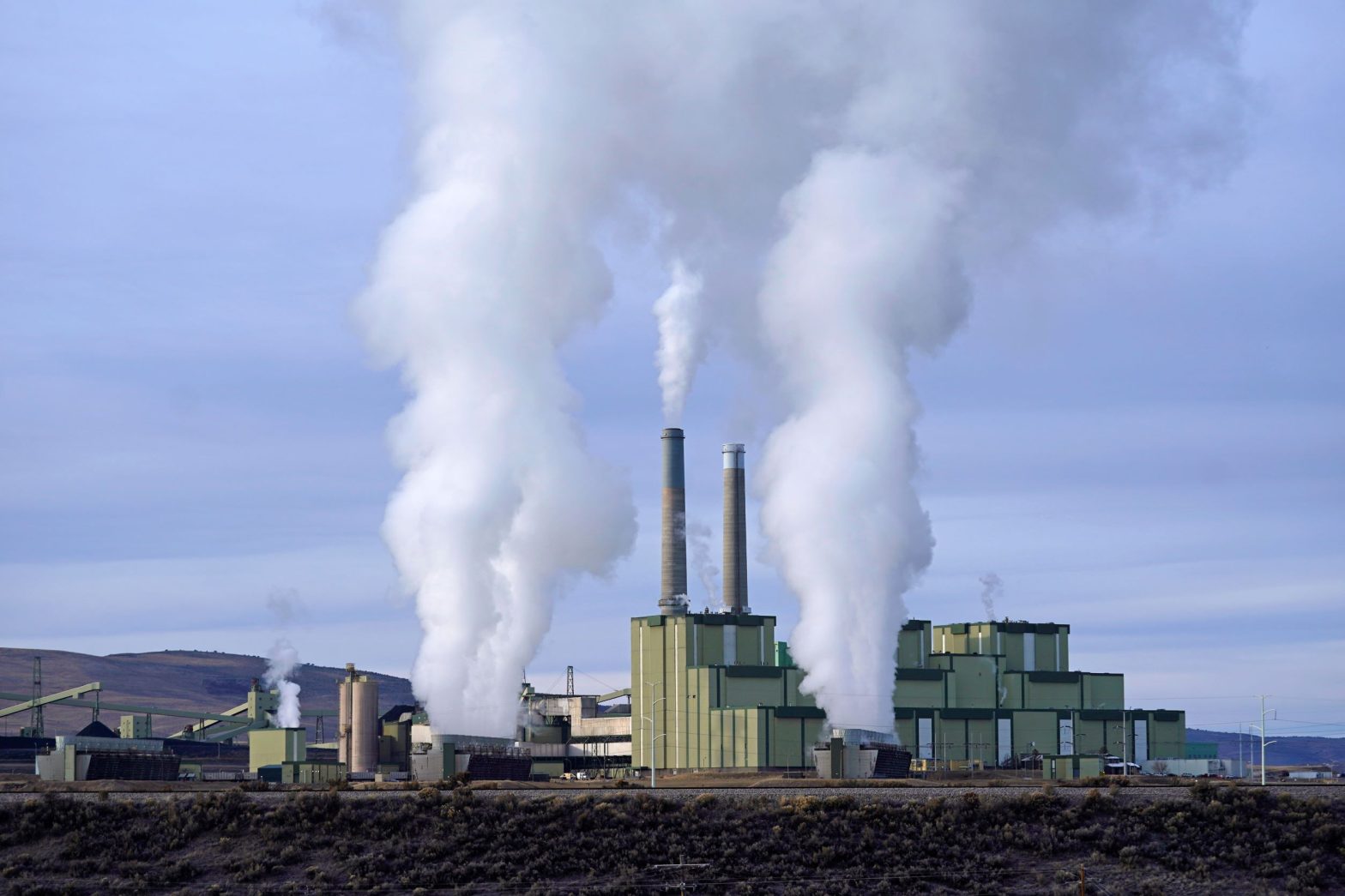Supreme Court Limits EPA Authority to Regulate Power Plant Emissions

WASHINGTON — The Supreme Court on Thursday dramatically limited the Environmental Protection Agency’s ability to regulate carbon emissions from power plants, dealing a major blow to the Biden administration’s efforts to address climate change.
The 6-3 ruling written by Chief Justice John Roberts largely revolved around the so-called “major questions doctrine,” which requires Congress to authorize in plain and direct language any sweeping actions by administrative agencies that could impact the economy.
The doctrine, a judicially created principle of statutory interpretation, follows from the premise that Congress, as the Supreme Court put it in its 2001 decision in the case Whitman v. American Trucking Ass’ns, “does not alter the fundamental details of a regulatory scheme in vague terms or ancillary provisions — it does not, one might say, hide elephants in mouseholes.”
With that in mind, Roberts concluded, “Capping carbon dioxide emissions at a level that will force a nationwide transition away from the use of coal to generate electricity may be a sensible ‘solution to the crisis of the day’ … [b]ut it is not plausible that Congress gave EPA the authority to adopt on its own such a regulatory scheme.”
The EPA’s view of its authority, Roberts wrote at another point in the ruling, “was not only unprecedented; it also effected a ‘fundamental revision of the statute, changing it from [one sort of] scheme of … regulation’ into an entirely different kind.”
“A decision of such magnitude and consequence rests with Congress itself, or an agency acting pursuant to a clear delegation from that representative body,” he concluded, remanding the case to a lower court.
The dissenters, led by Justice Elena Kagan, said the majority had effectively eviscerated the EPA’s “power to respond to the most pressing environmental challenge of our time.”
In a statement, President Joe Biden described the ruling as “another devastating decision that aims to take our country backwards.
“While this decision risks damaging our nation’s ability to keep our air clean and combat climate change, I will not relent in using my lawful authorities to protect public health and tackle the climate crisis,” the president said.
Biden said he’s directed his legal team to work with the Department of Justice and affected agencies to review the decision and find ways that the administration can, under federal law, continue protecting Americans from harmful pollution, including pollution that causes climate change.
“Since the Clean Air Act was passed by a bipartisan majority in Congress in 1970, the landmark law has enabled both Democratic and Republican administrations to protect and improve the air we breathe, cutting air pollution by 78 percent even as our economy quadrupled in size. Yet today’s decision sides with special interests that have waged a long-term campaign to strip away our right to breathe clean air,” he said.
“We cannot and will not ignore the danger to public health and existential threat the climate crisis poses. The science confirms what we all see with our own eyes – the wildfires, droughts, extreme heat, and intense storms are endangering our lives and livelihoods,” the president added.
Environmental and legal experts believe that this decision could be one of the most significant environmental rulings the court has ever reached. They say that the ruling to reduce the agency’s ability to set emission standards for greenhouse gases, such as carbon dioxide, will have a profound effect on national health and global climate change.
“The Supreme Court limit[ing] the EPA’s authority to regulate pollutants like carbon dioxide … would be profoundly damaging to human health, the planet and future generations,” Lynn Goldman, dean of George Washington University’s Milken Institute School of Public Health, said prior to the announcement of the Supreme Court’s decision.
Goldman, a pediatrician and epidemiologist who is also an expert on environmental health, submitted an amicus brief in the case, supporting the EPA.
“A decision by the high court to curtail EPA’s authority to regulate climate pollutants … accelerate[s] the damage caused by climate change,” Sabrina McCormick, an associate professor of environmental and occupational health at George Washington University, said.
McCormick’s 2017 study of climate lawsuits showed that air pollution and coal-fired power plants were at the center of most cases filed in the courts, and she believes this decision will “also make it much harder for our cities and society to mitigate the extreme weather and the threat to human health.”
According to data from the EPA, in 2020, the electricity sector was the second largest source of U.S. greenhouse gas emissions, accounting for about a quarter of the national total.
The underlying case, West Virginia v. Environmental Protection Agency, was a challenge to the EPA’s authority to regulate greenhouse gases, and it stems from former President Donald Trump’s 2018 decision to repeal the Obama administration’s Clean Power Plan and replace it with his own Affordable Clean Energy Rule.
The Clean Power Plan was President Barack Obama’s signature policy on climate change, and it established guidelines for states to limit carbon dioxide emissions from power plants.
Under the rule, which was finalized in 2015, the EPA assigned each state a goal for limiting emissions from existing power plants and gave the states broad latitude in meeting those goals, such as switching from coal to natural gas or building new wind or solar farms.
At the time, the agency estimated that the rule would have reduced greenhouse gas emissions from the power sector 32% below 2005 levels by 2030, and it was considered one of the strongest actions the U.S. had ever taken to combat climate change.
Finalized alongside the plan was a separate proposal by the EPA to regulate emissions from all new power plants, which would have effectively made it impossible to build a new coal plant in the United States unless it could capture and bury emissions underground.
But Trump was having none of this, believing, as the coal industry and some electrical utilities did, that the Obama-era rules were overly restrictive, unquestionably burdensome and job-killing.
On a visit to West Virginia, where he held a political rally in the heart of coal country, Trump told his audience the new administration loved “clean, beautiful, West Virginia coal.
“And you know, that’s indestructible stuff,” he told an audience that was eager to lap up his message.
“In times of war, in times of conflict, you can blow up those windmills, they fall down real quick. You can blow up pipelines, they go like this,” he said, gesturing with his hands.
“You can do a lot of things to those solar panels, but you know what you can’t hurt? Coal,” he added.
Trump’s Affordable Clean Energy rule was designed to give individual states vast authority to set more modest goals and to regulate emissions from coal plants as they see fit.
But even as Trump hailed his new policy, declaring it the end of a “war on coal,” his administration’s own analysis revealed his new rules could potentially lead to as many as 1,400 premature deaths annually by 2030.
And it laid the blame for these deaths on an increase in the extremely fine particulate matter, which it said could result in an increased prevalence of heart and lung disease, up to 15,000 new cases of upper respiratory problems, a rise in bronchitis, and tens of thousands of missed school days.
After the Biden administration moved to roll the Trump-era policy back, the state of West Virginia and state Attorney General Patrick Morrisey, as well as Republican attorneys general from more than a dozen other states and two coal companies, filed the lawsuit against the EPA stating the agency exceeds its congressional authority in forcing power plants to cut down their pollution.
The plaintiffs argued that the EPA does not have the authority to regulate power plant emissions as this power should instead be granted to Congress.
Indeed, while the core of the case was about power plant emissions, the decision has become one about how much power federal agencies have to enforce regulations of all kinds.
The EPA claimed its authority to regulate the nation’s air quality under the Clean Air Act, bedrock legislation that was passed in 1970.
“The only question before the court is narrow: whether the ‘best system of emission reduction’ identified by EPA in the Clean Power Plan was within the authority granted to the agency in Section 111(d) of the Clean Air Act,” Roberts wrote. “The answer is no.”
Almost as soon as the ruling was announced, a number of state governors began to weigh in on what it means.
As far as Republican Gov. Tate Reeves of Mississippi was concerned, the Supreme Court’s decision in West Virginia “struck a major blow against President Biden’s radical Green New Deal agenda.
“This means that the Biden administration can no longer circumvent Congress to enact extreme rules that undermine the democratic process and threaten our nation’s economy and power grid,” he said.
“Today’s decision … deals a serious loss to the seemingly never-ending attempts of the Biden administration and its mob of unelected and unaccountable woke bureaucrats to bypass Congress and make ‘laws’ through the administrative state,” he said.
Alternatively California Gov. Gavin Newsom, a Democrat, said that by siding with the fossil fuel industry, the Supreme Court had “kneecapped” the federal government’s basic ability to tackle climate change.
“Today’s ruling makes it even more imperative that California and other states succeed in our efforts to combat the climate crisis,” Newsom said. “While the court has once again turned back the clock, California refuses to go backward — we’re just getting started. California will remain the tentpole for this movement with record investments and aggressive policies to reduce pollution, to protect people from extreme weather, and to leave our children and grandchildren a world that’s better off than we found it.”
Similarly, New York Gov. Kathy Hochul, also a Democrat, called the Supreme Court’s decision “a major setback in our fight against climate change.”
“By limiting the Environmental Protection Agency’s ability to protect our environment, the court is taking away some of the best tools we have to address the climate crisis,” she said. “It presents three immediate priorities: The EPA must swiftly implement the strongest possible new emissions rule, states must redouble our climate efforts, and Congress must pass robust climate legislation this year to allow us to go further, faster.
“New York is once again in the familiar, but unwelcome, position of stepping up after the Supreme Court strikes a blow to our basic protections,” Hochul continued. “But as always, New York is ready. We will strengthen our nation-leading efforts to address the climate crisis, redouble efforts with sister states, build new clean energy projects in every corner of the state, and crack down on pollution harming the health of many New Yorkers. After this ruling, our work is more urgent than ever.”























